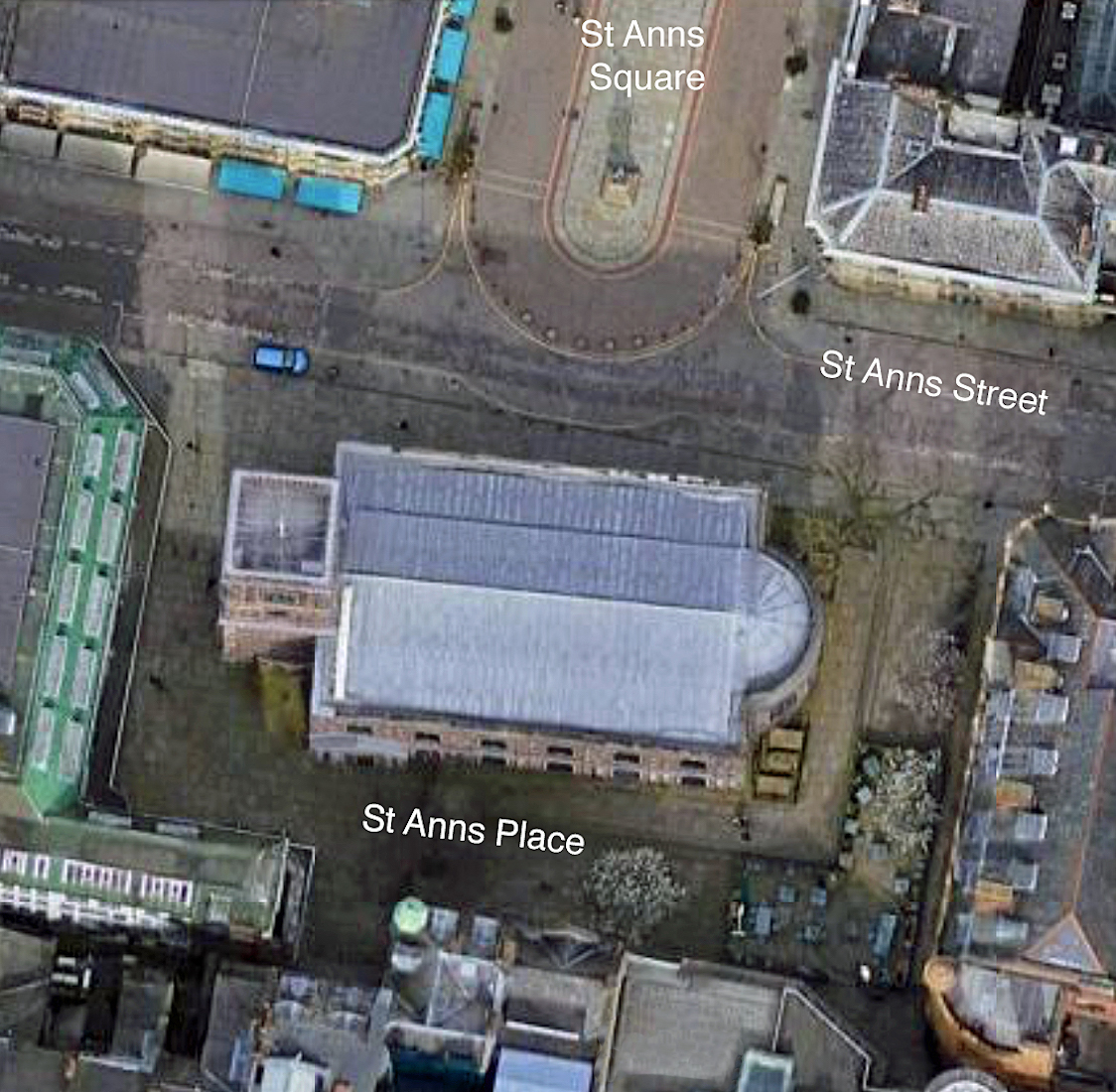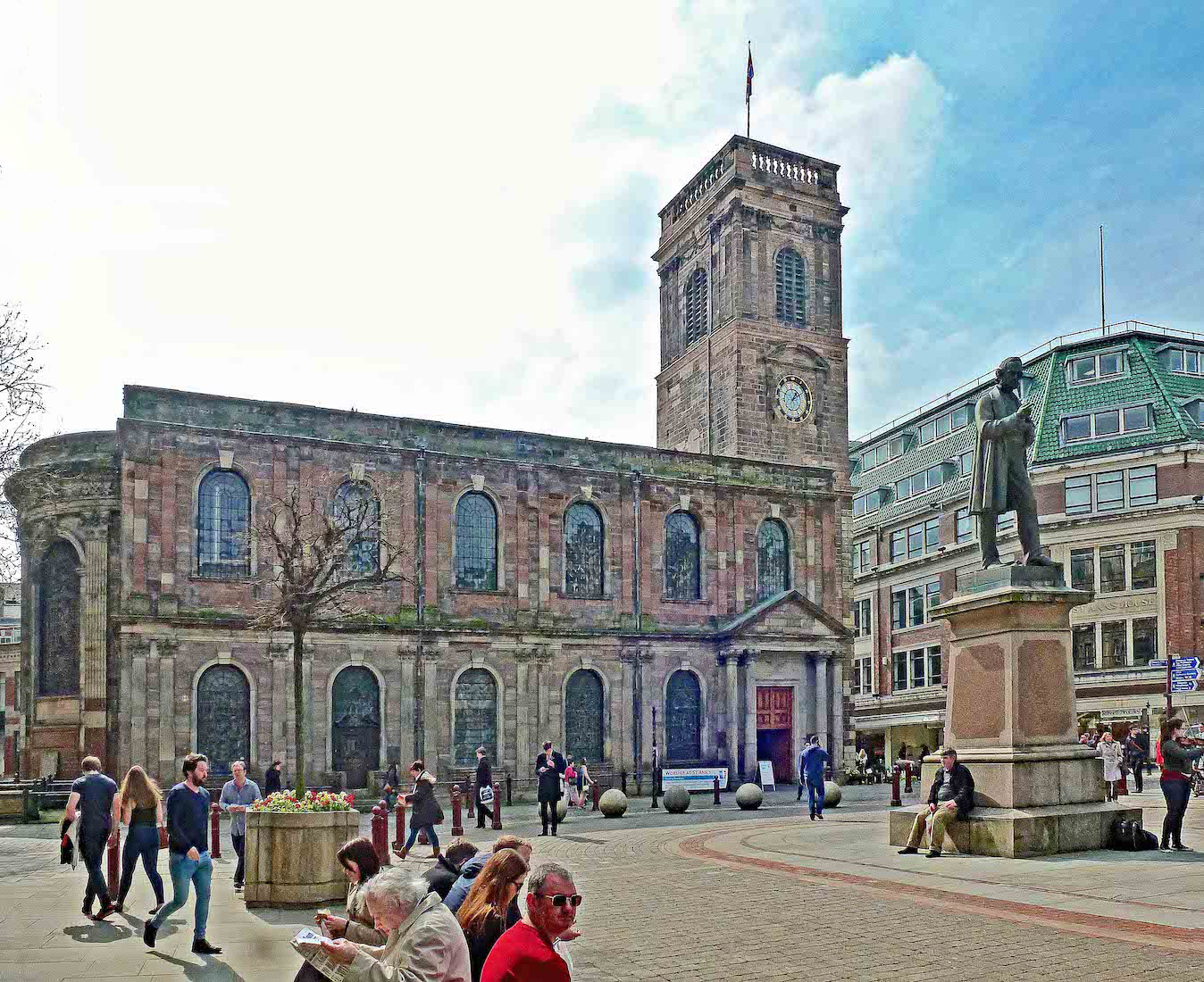I visited the little Church of St Ann in 2019 and fell in love with it. So it is a great pleasure for me to revisit it on this website.
With few exceptions, the photographs on this site have been taken by ‘Glass Angel’. The exceptions are accredited in the text. For more on this, see the Conclusion.
A brief history of this Church is given below. However, if you want to begin your tour of the Church immediately, tap / click on START . You can also access intermediate points in the tour by a tap / click on the following links:
NOTE ON MAGNIFYING IMAGES
With this website format the images are large enough for most purposes. If there is a need for greater magnification of an image, go to the identical photo on the appropriate website listed in the Conclusion.

SATELLITE VIEW
St Ann’s Church is located in central Manchester, lying between St Anns Street and St Anns Place, and at the southern end of St Anns Square. The apostrophe for the Church is intentional!
The axis of the Church is almost exactly east - west with the sanctuary to the east, so we can easily identify the geographical directions with our liturgical directions (for example East with a capital E for the orientation of the sanctuary). The Church is rectangular in shape with an apse at the Eastern end, and a square tower to the West. There are three entries at the West end: from the West, under the tower, or via the small North Porch or via the matching South Porch at the West end of the nave.
We shall begin our exploration near the prominent statue of Richard Cobden in the Square, approach the Church and then follow around the walls in a clockwise direction before entering at the West end.

PLAN
This plan of the Church interior is provided online by St Ann’s. References to the numbers are given below.
1. Altar
2. Lady Chapel
3. Organ Console
4. Lectern
5. Bookstall
6. Churchwardens’ Pew
7. Table for Prayer Requests
8. Pulpit
9. Candle Stand
10. Font
11. Chancel (Choir Stalls)
HISTORY
Years Built: 1709 – 1712
Address: St Anns Street
Simon Jenkins Rating: **
55 Major British Churches: x
Before the 18th century Manchester had only one church, now the Cathedral. As the town grew a new one was needed. Funds were provided by Lady Ann Bland and the design in the fashionable classical style is thought to be the work of John Barker. St Ann’s was consecrated in July 1712.
The stone used was the purplish red sandstone found nearby at Collyhurst. The stone is very soft and so material from several other quarries can be found on the exterior as repairs have been made over the years.
From 1887 – 89 the interior was remodelled by Alfred Waterhouse, architect of the Town Hall. He raised up the chancel, created the vestries and Lady Chapel and moved the pulpit to one side. At the West End the stairs and gallery were also changed. The original Communion Table, the gift of Lady Ann Bland, was put into the new Lady Chapel.
The Lady Chapel also contains the painting The Descent from the Cross painted in the manner of Annibale Carraci, born 1561. The picture was bought from Italy by a Churchwarden of St Peter’s and used to hang in that church until it was demolished in 1907. In a very different style altogether is the art deco window. It is in memory of Hilda Collens who founded the Northern School of Music in 1920. This School is now part of the Royal Northern College of Music whose students perform regularly in St Ann’s.
The organ, which dates from 1730, was originally on the West Gallery. It has grown over the years and is now a fine instrument with 54 speaking stops on which recitals are given every week. It was rebuilt by George Sixsmith & Co of Mossley in 1996.
St Ann’s narrowly escaped damage during the Manchester air raids by the Luftwaffe in the Second World War and still has a burnt-out incendiary bomb which fell onto the roof. In 1996 an IRA bomb devastated the city centre and caused the upstairs windows to be blown in on one side and out on the other. Fortunately the organ had been removed for rebuilding and so was preserved.
After more than 300 years St Ann’s is still a place of worship and cultural life in the heart of Manchester.
https://www.stannsmanchester.com/heritage/history-of-st-anns/



